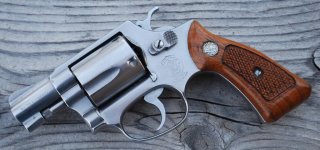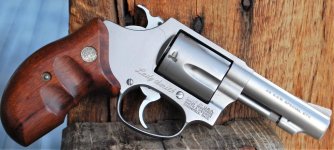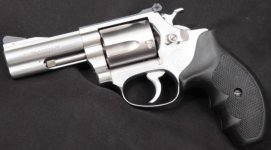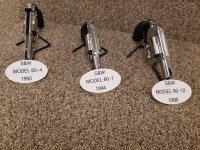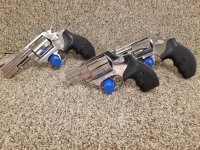This topic crosses two forum boundaries (not rules): 1965 - 1997.
Roy Jinks' book, History of Smith & Wesson, clearly identifies the early evolution of Model 60 hammers and triggers:
- stainless steel that wasn't "durable" enough
- color case hardened (were those carbon steel?)
- heat treated stainless steel that was then flash chrome finished
All my Model 60s (photos of several attached) have that last style or design hammers and triggers, except one. My June '97 shipped Model 60-10 has the J-magnum frame's flat-faced hammer, but both the hammer and trigger appear to be pre-MIM carbon steel that's been color case hardened.
Is that correct?
If so, do any of you know why S&W changed its decades-long standard for the 60-10? (I don't have any Model 60s between the 60-4 and 60-10 or subsequent to the 60-10 so I don't know what their H's and T's are).
Another oddity is the 60-4's serrated trigger, but it has the standard flash chrome finish so that's a whole different topic.
Thanks very much for sharing your thoughts.
Roy Jinks' book, History of Smith & Wesson, clearly identifies the early evolution of Model 60 hammers and triggers:
- stainless steel that wasn't "durable" enough
- color case hardened (were those carbon steel?)
- heat treated stainless steel that was then flash chrome finished
All my Model 60s (photos of several attached) have that last style or design hammers and triggers, except one. My June '97 shipped Model 60-10 has the J-magnum frame's flat-faced hammer, but both the hammer and trigger appear to be pre-MIM carbon steel that's been color case hardened.
Is that correct?
If so, do any of you know why S&W changed its decades-long standard for the 60-10? (I don't have any Model 60s between the 60-4 and 60-10 or subsequent to the 60-10 so I don't know what their H's and T's are).
Another oddity is the 60-4's serrated trigger, but it has the standard flash chrome finish so that's a whole different topic.
Thanks very much for sharing your thoughts.

